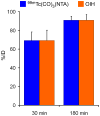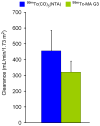(99m)Tc(CO)3(NTA): a (99m)Tc renal tracer with pharmacokinetic properties comparable to those of (131)I-OIH in healthy volunteers
- PMID: 20150248
- PMCID: PMC2852246
- DOI: 10.2967/jnumed.109.070813
(99m)Tc(CO)3(NTA): a (99m)Tc renal tracer with pharmacokinetic properties comparable to those of (131)I-OIH in healthy volunteers
Abstract
Studies in rats showed that the pharmacokinetics of the tricarbonyl core radiopharmaceutical (99m)Tc(CO)(3)-nitrilotriacetic acid, (99m)Tc(CO)(3)(NTA), were essentially identical to those of (131)I ortho-iodohippuran ((131)I-OIH), the clinical gold standard for the measurement of effective renal plasma flow. Our objective was to compare the pharmacokinetics of these 2 tracers in healthy volunteers.
Methods: (99m)Tc(CO)(3)(NTA) was prepared with commercially available NTA and a commercially available kit and isolated by reversed-phase high-performance liquid chromatography. Approximately 74 MBq (2 mCi) of (99m)Tc(CO)(3)(NTA) were coinjected with 9.25 MBq (250 microCi) of (131)I-OIH in 9 volunteers, and simultaneous imaging of each tracer was performed for 24 min. Plasma clearances were determined from 8 blood samples obtained 3-90 min after injection using the single-injection, 2-compartment model. Plasma protein binding, red cell uptake, and percentage injected dose in the urine at 30 and 180 min were determined.
Results: There was no difference in the plasma clearances of (99m)Tc(CO)(3)(NTA) and (131)I-OIH, 475 +/- 105 mL/min versus 472 +/- 108 mL/min, respectively. The plasma protein binding and red cell uptake of (99m)Tc(CO)(3)(NTA) were 43% +/- 5% and 9% +/- 6%, respectively; both values were significantly lower (P < 0.001) than the plasma protein binding (75% +/- 3%) and red cell uptake (17% +/- 5%) of (131)I-OIH. There was no significant difference in the percentage injected dose recovered in the urine at 30 min and at 3 h; for comparison, the percentage dose in the urine at 3 h was 91% +/- 4% for (99m)Tc(CO)(3)(NTA) and 91% +/- 6% for (131)I-OIH (P = 0.96). Image quality with (99m)Tc(CO)(3)(NTA) was excellent, and the renogram parameters were similar to those of (131)I-OIH.
Conclusion: Preliminary results in healthy volunteers suggest that the pharmacokinetic behavior of (99m)Tc(CO)(3)(NTA) is comparable to that of (131)I-OIH.
Figures





Similar articles
-
99mTc(CO)3(NTA) and 131I-OIH: comparable plasma clearances in patients with chronic kidney disease.J Nucl Med. 2013 Apr;54(4):578-84. doi: 10.2967/jnumed.112.108357. Epub 2013 Feb 19. J Nucl Med. 2013. PMID: 23424193 Free PMC article. Clinical Trial.
-
99mTc(CO)3-nitrilotriacetic acid: a new renal radiopharmaceutical showing pharmacokinetic properties in rats comparable to those of 131I-OIH.J Nucl Med. 2009 Mar;50(3):454-60. doi: 10.2967/jnumed.108.058768. Epub 2009 Feb 17. J Nucl Med. 2009. PMID: 19223406 Free PMC article.
-
Preclinical evaluation of 99mTc(CO)3-aspartic-N-monoacetic acid, a renal radiotracer with pharmacokinetic properties comparable to 131I-o-iodohippurate.J Nucl Med. 2012 Aug;53(8):1277-83. doi: 10.2967/jnumed.111.102236. Epub 2012 Jun 20. J Nucl Med. 2012. PMID: 22717977 Free PMC article.
-
Technetium-99m (99mTc) mercaptoacetyltriglycine: update on the new 99mTc renal tubular function agent.Semin Nucl Med. 1992 Apr;22(2):61-73. doi: 10.1016/s0001-2998(05)80082-0. Semin Nucl Med. 1992. PMID: 1534184 Review.
-
99mTc-Tricarbonyl–labeled aspartic-N-monoacetic acid (ASMA).2012 Aug 2 [updated 2012 Sep 13]. In: Molecular Imaging and Contrast Agent Database (MICAD) [Internet]. Bethesda (MD): National Center for Biotechnology Information (US); 2004–2013. 2012 Aug 2 [updated 2012 Sep 13]. In: Molecular Imaging and Contrast Agent Database (MICAD) [Internet]. Bethesda (MD): National Center for Biotechnology Information (US); 2004–2013. PMID: 22993874 Free Books & Documents. Review.
Cited by
-
Underscoring the influence of inorganic chemistry on nuclear imaging with radiometals.Inorg Chem. 2014 Feb 17;53(4):1880-99. doi: 10.1021/ic401607z. Epub 2013 Dec 6. Inorg Chem. 2014. PMID: 24313747 Free PMC article.
-
Head to head comparison of [99mTc]Tc(CO)3(NTA) and [99mTc]Tc-MAG3 in patients with suspected obstruction.EJNMMI Res. 2021 May 1;11(1):43. doi: 10.1186/s13550-021-00782-x. EJNMMI Res. 2021. PMID: 33934268 Free PMC article.
-
Structure and Properties of fac-[Re(I)(CO)3(NTA)](2-) (NTA(3-) = Trianion of Nitrilotriacetic Acid) and fac-[Re(I)(CO)3(L)](n-) Analogues Useful for Assessing the Excellent Renal Clearance of the fac-[(99m)Tc(I)(CO)3(NTA)](2-) Diagnostic Renal Agent.Inorg Chem. 2015 Jul 6;54(13):6281-90. doi: 10.1021/acs.inorgchem.5b00584. Epub 2015 Jun 12. Inorg Chem. 2015. PMID: 26068141 Free PMC article.
-
Biodistribution of (99m)tc tricarbonyl glycine oligomers.Toxicol Res. 2012 Dec;28(4):235-40. doi: 10.5487/TR.2012.28.4.235. Toxicol Res. 2012. PMID: 24278615 Free PMC article.
-
New monodentate amidine superbasic ligands with a single configuration in fac-[Re(CO)3(5,5'- or 6,6'-Me2bipyridine)(amidine)]BF4 complexes.Inorg Chem. 2012 Jul 2;51(13):7271-83. doi: 10.1021/ic300625n. Epub 2012 Jun 12. Inorg Chem. 2012. PMID: 22691073 Free PMC article.
References
-
- Marcus CS, Kuperus JH. Pediatric renal iodine-123 orthoiodohippurate dosimetry. J Nucl Med. 1985;26:211–214. - PubMed
-
- Fritzberg AR, Kasina S, Eshima D, Johnson DL. Synthesis and bilogical evaluation of technetium-99m MAG3 as a hipurran replacement. J Nucl Med. 1986;27:111–116. - PubMed
-
- Taylor A, Eshima D, Fritzberg AR, Christian PE, Kasina S. Comparison of iodine-131 OIH and technetium-99m MAG3 renal imaging in volunteers. J Nucl Med. 1986;27:795–803. - PubMed
-
- Russell CD, Thorstad B, Yester MV, Stutzman M, Baker T, Dubovsky EV. Comparison of technetium-99m MAG3 with iodine-131 hippuran by a simultaneous dual channel technique. J Nucl Med. 1988;29:1189–1193. - PubMed
-
- Schaap GH, Alferink THR, de Jong RBJ, et al. 99mTc-MAG3: Dynamic studies in patients with renal disease. Eur J Nucl Med. 1988;14:28–31. - PubMed
Publication types
MeSH terms
Substances
Grants and funding
LinkOut - more resources
Full Text Sources
Other Literature Sources
